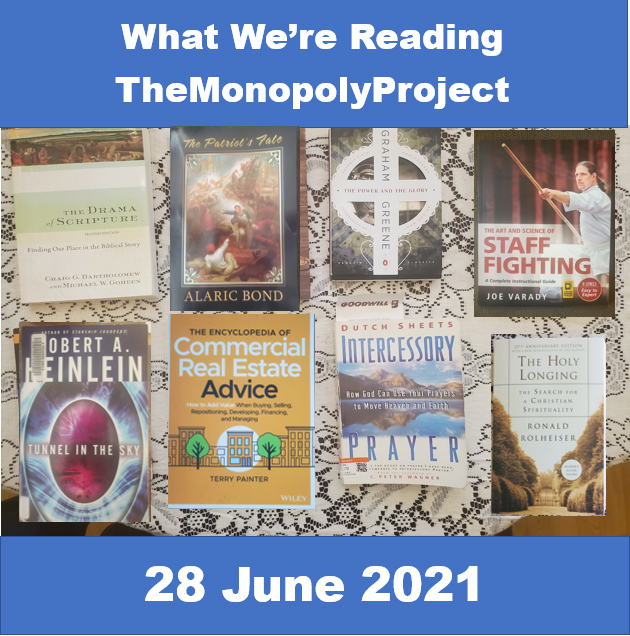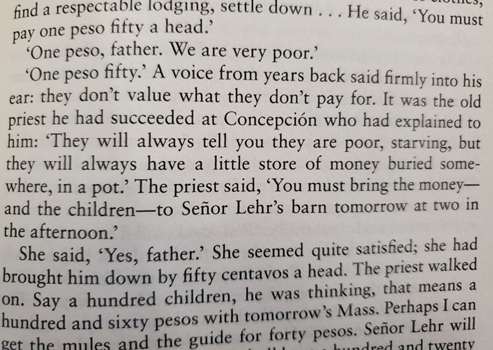Every month we show what is on our reading table.

Comments on current reads:
1. “The Drama of Scripture” by Craig G. Bartholomew and Michael W. Goheen: Recommended by Pastor Jeff. I skimmed the first two chapters and really like this approach. Let’s see how it ends.
2. “The Patriot’s Fate” by Alaric Bond. I read and reviewed the first four books in this British Naval Fiction, “His Majesty’s Ship”, “The Jackass Frigate” True Colors”, and “Cut and Run”. I give them high marks. Now that I read the first four installment in the series, I like it even more. I learned that the author does not center the series and each book around the captain. All the other series are about the captain rising from humble or noble beginnings to the end of an illustrious career. In Bond’s world, he follows a cross section of the crew, from the lowest to the captain. You are never sure who will survive and who won’t. In the first book, the captain, who I liked, died at the very beginning of the climactic battle. In this second, the captain, again who I like as a character, he survives. I hope to see him again. I’m trying to ration myself to one per month.
3. “The Power and the Glory” by Graham Greene: I am a big Graham Greene fan and am re-reading this book because it came up in a conversation about charging late fees at our medical practice, Ahwatukee Health and Recovery. We just started charging late fees and no-show fees since everyone was taking advantage of our mercy. In the book, the ‘whisky’ priest is advised that he should always charge for giving Mass and baptisms or the peasants will not appreciate the sacraments. Here (Part 3, Chapter 1, p169) he is bargaining on the price of baptisms:

4. “Staff Fighting” by Joe Varady. I bought this book as an alternative to “Cane Fighting: The Authoritative Guide to Using the Cane or Walking Stick for Self-Defense” which was recommended by Helen of Instapundit. The Varady book is a quick read with lots of good illustrations. If I was 40 years younger, I might try some of the moves. I was somewhat disappointed that he did not discuss two aspects of using the staff: One, defense against four footed predators. The most likely time you are going to be carrying a staff and encounter a dangerous animal is on a hike. And two, defense against a knife threat. Obviously, a gun would be better in both instances, but the premise is that all you have is the staff. Look for a few more comments in The Floating Book Review to follow. As an aside, the “Cane Fighting:…” book had lots of negative reviews which I found disqualifying.
5. “Tunnel In the Sky” by Robert Heinlein. This is one of Heinlein’s “juvenile” books; meant for young (read teenager or less) readers. He also wrote a lot of hard, science fiction of which I am a big fan (Stranger in a Strange Land, Starship Troopers, The Moon Is a Harsh Mistress, Time Enough for Love, The Door into Summer, The Cat Who Walks Through Walls, Methuselah’s Children.). Heinlein was an eclectic, strange person. Even in today’s climate. He was a libertarian with heterodox views on sex, race, culture and everything. The protagonist of “Tunnel In the Sky” is African American although this is not explicitly stated. That was an unacceptable view in 1955 America. Heinlein admitted that in an interview. Here is the cover of an audio version that acknowledges this truth.

Thanks to my friend Megan at the Coolidge library for getting me the copy of “Tunnel In The Sky”. And she also got me the Grover Cleveland book. Both are expensive online.
6. “The Encyclopedia of Commercial Real Estate Advice” by Terry Painter (not pictured): Still in work. The few times I dipped into it; I was impressed.
7. “Intercessory Prayer” by Dutch Sheets: I just started reading this. I have read the first two chapters. If the rest is as good, and as documented, this is an OUTSTANDING book on what is intercessory prayer and how to do it. I like his explanation of theology and how he backs each claim with scripture.
8. ” The Holy Longing: The Search for a Christian Spirituality” by Ronald Rolheiser: I bought this book based on a recommendation from my sister. I’m more than halfway through it and it is OUTSTANDING. Note that it is difficult reading. You have to think. It is deep. He does not quote scripture because he assumes you know what he is referring to. Two things tipped me off that I would like this book: One, he states facts that are obviously true but unappreciated. Two, he reached a lot of the same conclusions that I do. I will give examples of both in the upcoming Floating Book Review. So, do I like the book because he agrees with me, or vice versa? Not really. It is based on scripture, meticulously reasoned and practical.
Here’s a typical review that mirrors my thoughts:
9. “The One Year Bible” with help from the “Lutheran Study Bible” (neither pictured).
Photo courtesy of VerseoftheDay:

